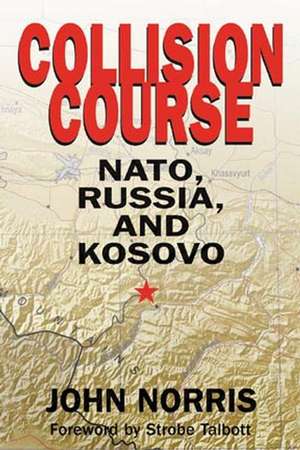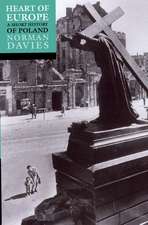Collision Course: NATO, Russia, and Kosovo
Autor John Norrisen Limba Engleză Hardback – 29 mar 2005 – vârsta până la 17 ani
Preț: 360.10 lei
Preț vechi: 417.63 lei
-14% Nou
Puncte Express: 540
Preț estimativ în valută:
68.91€ • 71.68$ • 56.89£
68.91€ • 71.68$ • 56.89£
Carte tipărită la comandă
Livrare economică 15-29 aprilie
Preluare comenzi: 021 569.72.76
Specificații
ISBN-13: 9780275987534
ISBN-10: 0275987531
Pagini: 360
Dimensiuni: 156 x 235 x 33 mm
Greutate: 0.72 kg
Ediția:New.
Editura: Bloomsbury Publishing
Colecția Praeger
Locul publicării:New York, United States
ISBN-10: 0275987531
Pagini: 360
Dimensiuni: 156 x 235 x 33 mm
Greutate: 0.72 kg
Ediția:New.
Editura: Bloomsbury Publishing
Colecția Praeger
Locul publicării:New York, United States
Notă biografică
JOHN NORRIS is the senior political adviser with the United Nations Mission in Nepal. He also served as the Washington Chief of Staff for the International Crisis Group while conducting a wide range of field work in Asia, Africa, and the Balkans.
Cuprins
Foreword by Strobe TalbottPrefaceIntroductionMisadventurePicking Up the PiecesThe Shuttle BeginsThe Dog Days of SpringAn Empty Chair, Nothing Off the TableOn the MountainBelgradeBreaking ThroughDeception and ConfrontationA Creeping Coup?The AftermathConclusions: Hard LessonsBibliographyThe AuthorIndex
Recenzii
Norris, now with the International Crisis Group, was Deputy Secretary of State Strobe Talbott's communications director during the Clinton Administration. His book recounts the immediate genesis and outcome of the 1999 Kosovo crisis. The author has the advantage of an insider's experience..Recommended. Upper-division undergraduates, graduate students, and practitioners.
^ICollision Course: NATO, Russia, and Kosovo^R tells the story of the real diplomacy behind the Kosova crisis..[n]o one has told this important story in more detail or uncovered so many points at which things went disastrously wrong.
As communications director for U.S. Deputy Secretary of State Strobe Talbott, the lead American negotiator during the war, John Norris had a ringside seat for the diplomacy that ultimately produced a settlement. The story is a dramatic one, and Norris tells it well, drawing the reader into the web of relationships within and between the countries involved..Norris is particularly good at conveying just how grueling diplomacy can be. The number of flights that Talbott and his team took to Europe and Moscow, resulting in a marathon series of exhausting negotiations, is extraordinary..[e]ven readers familiar with the general contours of the Kosovo war will learn a great deal from an extraordinary tale-one that is told extraordinarily well.
[N]o one has pulled the war's tale together quite as Norris has--teaching even those who had central roles, such as the Finnish president, Martti Ahtisaari, things they id not know. Becuase NATO allies also often did not agree, and even the U.S. commander in Europe fought with the U.S. secretary of defense, it makes for a saga as tempestuous as it was crucial.
[E]xamines the multilateral diplomacy surrounding the Kosovo war. Author John Norris was communications director for U.S. Deputy Secretary of State Strobe Talbott, the lead diplomat for the United States on the crisis, and his book provides a highly readable, blow-by-blow history of the diplomacy that sought to resolve the conflict. As presented by Norriss book, the Kosovo conflict suggests that aggressive multilateral diplomacy, coupled with the use of limited force, can perhaps solve such disputes, or at least prevent the worst outcomes for them.
[A]n important and exciting story told with verve and a lot of detail by the author..The debate will continue, and this interesting, well-researched book is a valuable addition to it.
Norris judges the diplomacy as largely successful, but offers cautionary notes about the fragility of alliances with Europe and the challenges of engaging Russia.
^ICollision Course: NATO, Russia, and Kosovo^R tells the story of the real diplomacy behind the Kosova crisis..[n]o one has told this important story in more detail or uncovered so many points at which things went disastrously wrong.
As communications director for U.S. Deputy Secretary of State Strobe Talbott, the lead American negotiator during the war, John Norris had a ringside seat for the diplomacy that ultimately produced a settlement. The story is a dramatic one, and Norris tells it well, drawing the reader into the web of relationships within and between the countries involved..Norris is particularly good at conveying just how grueling diplomacy can be. The number of flights that Talbott and his team took to Europe and Moscow, resulting in a marathon series of exhausting negotiations, is extraordinary..[e]ven readers familiar with the general contours of the Kosovo war will learn a great deal from an extraordinary tale-one that is told extraordinarily well.
[N]o one has pulled the war's tale together quite as Norris has--teaching even those who had central roles, such as the Finnish president, Martti Ahtisaari, things they id not know. Becuase NATO allies also often did not agree, and even the U.S. commander in Europe fought with the U.S. secretary of defense, it makes for a saga as tempestuous as it was crucial.
[E]xamines the multilateral diplomacy surrounding the Kosovo war. Author John Norris was communications director for U.S. Deputy Secretary of State Strobe Talbott, the lead diplomat for the United States on the crisis, and his book provides a highly readable, blow-by-blow history of the diplomacy that sought to resolve the conflict. As presented by Norriss book, the Kosovo conflict suggests that aggressive multilateral diplomacy, coupled with the use of limited force, can perhaps solve such disputes, or at least prevent the worst outcomes for them.
[A]n important and exciting story told with verve and a lot of detail by the author..The debate will continue, and this interesting, well-researched book is a valuable addition to it.
Norris judges the diplomacy as largely successful, but offers cautionary notes about the fragility of alliances with Europe and the challenges of engaging Russia.












